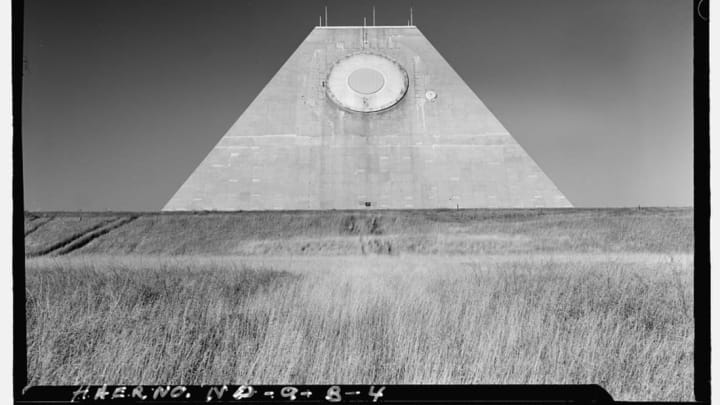If you want to learn about someplace, you can always pick up a textbook. But if you want to get to know a place, you're going to have to dig a little deeper. And what you find there might be a little strange. The Strange States series will take you on a virtual tour of America to uncover the unusual people, places, things, and events that make this country such a unique place to call home. Today we’re headed to the Roughrider State—North Dakota.
NORTH DAKOTA'S ANTI-BALLISTIC BASE
Breaking the expansive plains near Nekoma, North Dakota, is a flat-topped pyramid that stands nearly 80 feet high. On each slanted side of the building are large, white circles, like eyes keeping constant watch on the skies. As odd as it sounds, this structure was not built by ancient Mayans or visiting extraterrestrials, but by the United States Military as part of the Safeguard anti-ballistic missile (ABM) program of the 1970s.
Officially known as the Stanley R. Mickelsen Safeguard Complex, the 470-acre complex was one of three planned defensive missile sites in the U.S. Aside from one that would have protected Washington D.C., the other site, in Montana, was canceled after the Anti-Ballistic Missile Treaty signed in 1972 reduced the number of allowable sites to two. In 1974, after construction at the North Dakota base was nearly complete, a new protocol was added to the treaty that limited the number of sites to one, making the Mickelsen Safeguard Complex the only ABM base built in the U.S.
Construction began in April 1970, requiring the work of about 3200 employees at peak stages. It’s been estimated that over 714,000 cubic feet of concrete was poured over 44 million pounds of rebar and 27,500 tons of reinforcing steel. Over 2200 miles of electrical wire, 750 miles of conduit, and over 40 miles of pipes connected the buildings and underground tunnels that made up the complex.
To watch for incoming intercontinental ballistic missiles (ICBM), an advanced radar system housed in the 80-foot pyramid gave a 360-degree view of much of America and Canada. To thwart incoming threats, the site featured 100 missile silos, the maximum number allowed under the 1972 treaty. Thirty long-range Spartan missiles were meant to destroy warheads above the atmosphere, while 70 short-range Sprint missiles were a last line of defense that could intercept an ICBM within the atmosphere, but prevent it from hitting the ground and doing maximum damage.
After nearly five years at a total cost of over $468 million, the base officially opened at full weapons capacity on October 1, 1975. On October 2, 1975, Congress voted to deactivate the Safeguard Anti-Ballistic Missile program.
In the five years that the Mickelsen complex had been under construction, Russian technology had advanced significantly to accommodate multiple warheads on a single missile. Military experts believed this would overwhelm the existing Safeguard system, essentially rendering it useless. Tactical operation at the Mickelsen Safeguard Complex was terminated in November 1975, and the base was closed by July 1976.
The site sat deteriorating in the harsh North Dakota winters until 1991, when the U.S. Military reopened portions of the site as the Cavalier Air Force Station. Both civilian and military employees currently use the base to monitor potential missile launches, as well as military and civilian satellites in orbit.
Have the scoop on an unusual person, place or event in your state? Tell me about it on Twitter (@spacemonkeyx) and maybe I’ll include it in a future edition of Strange States!
Peruse the whole Strange States series here.
